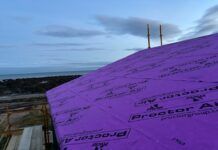The dangers of working at height and the importance of best practice has been highlighted again by two recent cases of safety failings. One case involved a 42-year-old man sub-contracted by McKeown Groundworks, who fell seven metres through a fragile roof. As he walked along the roof he stepped on a translucent light panel, which broke under his weight resulting in his falling through the roof to the ground below. The worker suffered a compression fracture of the lower back as a result of this incident. An investigation by the Health and Safety Executive (HSE) found that McKeown Groundworks failed to adequately supervise this work at height and relied on the experience of the workers to avoid injury while working at height.
It was also found that McKeown failed to plan the work at height and therefore no control measures had been put in place to prevent workers falling from or through the roof. The company was fined £12,000 after pleading guilty to breaching Regulation 4 of the Work at Height Regulations, 2015.
Speaking after the hearing, HSE inspector Helen Diamond, said: “McKeown’s failings resulted in serious injuries, which could have easily been prevented had the company planned the work at height. Planning the work at height would have included an assessment of the risks and ensuring that suitable and sufficient measures were in place to prevent falls from height.
“Work at height is the biggest single cause of fatal and serious injury in the construction industry, particularly on small projects.”
Another case fortunately did not involve any accidents -– but the potential for serious injury was there. Brighton Magistrates Court heard how numerous concerns were raised by members of the public about work being carried out by G & S Roofing. The company twice ignored written advice to address the issue of working at height in an unsafe manner.
In August 2016, a further concern was raised by a member of the public who contacted HSE after seeing more evidence of operatives hired by G & S Roofing working unsafely from height. Inspectors then visited the site.
The HSE investigation found one of the operatives to be working on the flashings of a chimney from a ladder resting on the pitch of the roof at the unguarded gable end of the two-storey house. There was nothing at the gable end of the roof to prevent a person falling. There were no suitable measures in place to prevent a person falling from the gable end, a fall which could have caused personal injury. A prohibition was served but the company took no action to rectify the dangerous working conditions.
G & S Roofing was found guilty in its absence to breaching Regulations 4(1)(a) and 4(1)(c) of the Work at Height Regulations 2005 by virtue of Regulation 3(b). The company was fined a total of £80,000 and ordered to pay costs of £4,574.
The dangers of working at height are well known and it is the contractor’s duty to ensure that all work carried out is properly assessed and controls are put in place to minimize the risk of serious injury.



